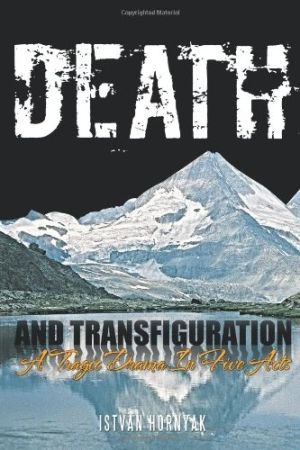Death and Transfiguration
A Tragic Drama in Five Acts
Istvan Hornyak’s Death and Transfiguration: A Tragic Drama in Five Acts is an operatic, intriguing, somewhat misguided, and turgid retelling of the tale of Faust. According to legend, Dr. Henry Faust is a sagacious, peerless scholar who, exhausted and disillusioned by a life spent relentlessly pursuing knowledge, sells his soul to Mephistopheles (Satan) for a chance to backpedal and satiate his need for carnal and other raucous, pleasure-driven sensations.
On the positive side, this play is nothing if not thorough, and probably, in comparison to other versions of the legend, a triumph of elucidation. Whether or not readers agree with Hornyak’s particular spin on the familiar narrative, the author succeeds at refining and clarifying the dominant themes of devotion, spiritual revelation, despair, cynicism, and the nature of God’s role in temptation.
Hornyak disabuses readers of the notion that poor, decrepit Dr. Faust, weary from worshipping at the temple of intellect (without faith or altruism), wants to forfeit wisdom for the sake of rich, exuberant sensuality. According to Hornyak, Faust is unapologetically spiritual, if not necessarily pious, and randy as the next swinging lad. He is overcome with appropriate ardor for his wife, Margaret, and rejects Mephistopheles on several occasions before coming dangerously close to perdition.
In many ways, the crucible Faust is subjected to is far more nuanced and prolonged than any tortures Job endured. Hornyak’s version begins with Faust’s return from an arduous, disappointing pilgrimage; the story spends much time in retrospection before winding its way to a magnanimous, if passive, resolution.
When dealing with such broad, cosmological topics as the fight for Faust’s (and therefore, mankind’s) soul, perhaps one strategy is resorting to the kind of arch, grandiose diction that Hornyak employs: “Of budding roses, dressed in auburn tresses soft as feathered down. / I held with joy your golden ring, your troth within my hand.” The author seems to love embellishment, and while readers might excuse this extravagance as a kind of lyricism, the writing can get tedious.
The entire script is written in verse that is chockful of, but mercifully not limited to, rhyme. Hornyak is a gifted writer, as evidenced by the lengths he goes to describe the meadows, lakes, mountains, flowers, and other natural phenomena of Switzerland. But unlike similar writers who bask in elaboration (Thomas Wolfe, William Faulkner), he hasn’t quite marshaled the substance to match his abundant prose.
Reading Death and Transfiguration, one might wonder if it was conceived and crafted less for production than individual perusal. Hornyak brings insightful ideas to the table, particularly when it comes to questions of judgment and transgression, but his delight in language is just too much in evidence. There is an expression heard often in writer’s workshops: “Kill the darlings.” There are times when sumptuousness must be sacrificed for the sake of access. Hornyak’s take on the Faust legend would benefit from such guidance.
Reviewed by
Christopher Soden
Disclosure: This article is not an endorsement, but a review. The publisher of this book provided free copies of the book and paid a small fee to have their book reviewed by a professional reviewer. Foreword Reviews and Clarion Reviews make no guarantee that the publisher will receive a positive review. Foreword Magazine, Inc. is disclosing this in accordance with the Federal Trade Commission’s 16 CFR, Part 255.

